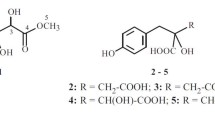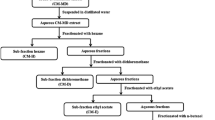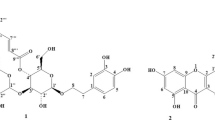Abstract
This study investigates phenolic components from the Panax ginseng C.A. Meyer leaves led to the isolation of 3 flavonoids (1–3). Their structures were characterized on the basis of physicochemical properties, nuclear magnetic resonance (NMR) spectra, electron spray ionization-mass spectrometry (ESI-MS) data, and comparison with those in the literature. Of them, sophoraflavonoloside (2) and prunin (3) were found to inhibit the growth of HL-60 human leukemia cells with IC50 in values of 29.8 and 21.4 μM by the induction of apoptosis.
Similar content being viewed by others
References
Park JD, Rhee DK, Lee YH. Biological activities and chemistry of saponins from Panax ginseng C.A. Meyer. Phytochem. Rev. 4: 159–175 (2005)
Shibata S. Chemistry and cancer preventing activities of ginseng saponins and some related triterpenoid compounds. J. Korean Med. Sci. 16: 28–37 (2001)
Seog HM, Jung CH, Choi IW, Park YK, Cho HY. Identification of phenolic compounds and quantification of their antioxidant activities in roasted wild ginseng (Panax ginseng C.A. Meyer) leaves. Food Sci. Biotechnol. 16: 349–354 (2007)
Kim SI, Kang KS, Lee YH. Panaxyne epoxide, a new cytotoxic polyyne from Panax ginseng root against L1210 cells. Arch. Pharm. Res. 12: 48–51 (1989)
Lu W, Zheng GR, Shen JS, Cai JC. Synthesis of the (3R,9S,10S)-diastereoisomer of panaxytriol, a potent antitumor polyacetylene from Panax ginseng. Chinese Chem. Lett. 10: 201–204 (1999)
Mosmann T. Rapid colorimetric assay for cellular growth and survival: Application to proliferation and cytotoxicity assays. J. Immunol. Methods 65: 55–63 (1983)
Budzianowski J. Kaempferol glycosides from Hosta ventricosa. Phytochemistry 29: 3643–3647 (1990)
Bohm BA, Phillips DW, Ganders FR. Flavonoids of Erythroxylum rufum and Erytiiroxylum ulei. J. Nat. Prod. 44: 676–679 (1981)
Shi Y, Gaestel M. In the cellular garden of forking paths: How p38 MAPKs signal for downstream assistance. Biol. Chem. 383: 1519–1536 (2002)
Pearson G, Robinson F, Gibson TB, Xu B, Karandikar M, Berman K, Cobb MH. Mitogen-activated protein (MAP) kinase pathways: Regulation and physiological functions. Endocr. Rev. 22: 153–183 (2001)
Scheid MP, Woodgett JR. Unravelling the activation mechanisms of protein kinase B/Akt. FEBS Lett. 546: 108–112 (2003)
Nicholson KM, Anderson NG. The protein kinase B/Akt signalling pathway in human malignancy. Cell Signal. 14: 381–395 (2002)
Boise LH, Gonzalez-Garcia M, Postema CE, Ding L, Lindsten T, Turka LA, Mao X, Nunez G, Thompson CB. Bcl-x, a bcl-2-related gene that functions as a dominant regulator of apoptotic cell death. Cell 74: 597–608 (1993)
Kroemer G. The proto-oncogene Bcl-2 and its role in regulating apoptosis. Nat. Med. 3: 614–620 (1997)
Hibasami H, Achiwa Y, Fujikawa T, Komiya T. Induction of programmed cell death (apoptosis) in human lymphoid leukemia cells by catechin compounds. Anticancer Res. 16: 943–1946 (1996)
Iwasaki R, Ito K, Ishida T, Hamanoue M, Adachi S, Watanabe T, Sato Y. Catechin, green tea component, causes caspase-independent necrosis-like cell death in chronic myelogenous leukemia. Cancer Sci. 100: 349–356 (2009)
Chen Y, Wu Q, Cui GH, Chen YQ, Li R. Deguelin blocks cells survival signal pathways and induces apoptosis of HL-60 cells in vitro. Int. J. Hematol. 89: 618–623 (2009)
Author information
Authors and Affiliations
Corresponding author
Rights and permissions
About this article
Cite this article
Tung, N.H., Son, JH., Cho, K. et al. Phenolic components from the leaves of Panax ginseng and their effects on HL-60 human leukemia cells. Food Sci Biotechnol 19, 271–274 (2010). https://doi.org/10.1007/s10068-010-0040-z
Received:
Revised:
Accepted:
Published:
Issue Date:
DOI: https://doi.org/10.1007/s10068-010-0040-z




